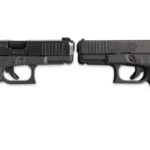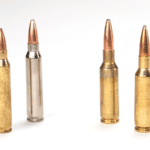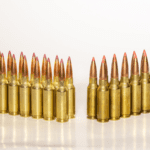Understanding the ballistics of various ammunition types is essential when dealing with firearms. The inquiry, “How Far Does a 9mm Bullet Travel Before It Drops?” is one that is frequently asked by those who are interested in firearms. In this article, we will dig into the entrancing universe of 9mm ballistics and shed light on the successful scope of a 9mm shot. We hope to provide you with a comprehensive understanding of the subject by examining various factors that influence bullet trajectory and drop.
How Far Does a 9mm Bullet Travel Before It Drops?
Like any other projectile, a 9mm round loses altitude gradually as it moves through the air because of gravity. The muzzle velocity, bullet weight, barrel length, and environmental conditions all influence the maximum distance a 9mm round can travel before falling. Let’s examine each of these components in greater detail to comprehend how they affect bullet trajectory and effective range.
Muzzle Velocity: The Driving Force
Muzzle velocity is the speed at which a bullet leaves the barrel of a firearm and is measured in feet per second (fps). A higher gag speed ordinarily brings about a compliment direction and a more drawn out distance went before the shot drops. For a run of the mill 9mm round shot from a handgun, the gag speed can go from around 900 to 1,400 fps.
Weight of Bullet: Keeping Power and Speed in Check
The weight of a bullet is another important aspect that has an effect on its trajectory. By and large, heavier slugs will quite often hold more dynamic energy and oppose drag, permitting them to travel farther prior to dropping. Bullet weights for 9mm ammunition can range from 115 to 147 grains, with 124 grains being the most common choice.
Barrel Length: Unleashing Potential
The bullet’s velocity and performance as a whole are influenced by the length of the gun’s barrel. Higher muzzle velocities are brought about by longer barrels because they give the expanding gases more time to accelerate the bullet. As a result, a 9mm round fired from a handgun with a longer barrel may have a greater effective range than one fired from a pistol with a shorter barrel.
Conditions of the environment: Combating Air Resistance
A bullet’s trajectory can be significantly affected by environmental factors like wind and air density. The bullet’s ability to maintain velocity is impacted by factors like altitude and temperature that influence air density. Thicker air typically results from lower temperatures and higher altitudes, allowing the bullet to travel further with less drag. On the other hand, denser air at lower heights can prompt diminished distance and expanded shot drop.
Common Queries On “How Far Does a 9mm Bullet Travel Before It Drops?”
The following are some frequently asked questions about the distance a 9mm bullet travels before it drops:
How far could a 9mm slug at any point go before it drops?
Depending on a number of factors, a 9mm bullet’s effective range for handguns is typically between 50 and 100 yards. Notwithstanding, it’s critical to take note of that shot drop turns out to be more articulated as the distance increments.
Can a 9-millimeter round travel a mile?
While it is hypothetically workable for a 9mm shot to travel a mile, it is exceptionally improbable. The bullet would have lost a lot of velocity and experienced a lot of bullet drop by the time it reached this distance, making it inaccurate and ineffective.
What factors can affect the distance traveled by a 9 mm bullet before it falls?
The distance a 9mm bullet travels before falling can be affected by a number of factors. These include the firearm used, the muzzle velocity, the weight of the bullet, the length of the barrel, the environment (such as air density and wind), and other factors.
Can the effective range of a bullet be affected by the type of ammunition?
Yes, a 9mm bullet’s effective range can be affected by ammunition. There are a variety of bullet designs, powder charges, and overall performance variations produced by various manufacturers of 9 mm rounds. Because this can affect the velocity and trajectory of the bullet, it is essential to choose ammunition of high quality that meets your specific requirements.
Does shot drop influence exactness?
Accuracy is affected by bullet drop, particularly at greater distances. To ensure accurate hits on the target, the shooter must adjust the aiming point as the bullet loses altitude. For accurate shooting, it is essential to comprehend the trajectory of the bullet and the amount of bullet drop at various distances.
Are there any strategies to relieve projectile drop?
Shooters frequently employ a variety of strategies to reduce bullet drop, such as adjusting the sights or optics to account for the drop at specific distances. Also, leveling up marksmanship abilities, including appropriate trigger control and steady pointing, can help make up for slug drop and further develop precision.
Summary
In conclusion, the muzzle velocity, bullet weight, barrel length, and environmental conditions all play a role in determining how far a 9mm round can travel before falling. While the viable scope of a 9mm shot ordinarily goes from 50 to 100 yards for handguns, it’s vital to consider that projectile drop turns out to be more articulated as the distance increments.
Understanding these variables and their impact on slug direction is fundamental for shooters to make exact and viable shots.
Likewise with any gun related point, it is essential with focus on security and comply to every appropriate regulation and guidelines. Always shoot responsibly and get the right training to improve your skills. By doing this, you can enjoy shooting while protecting yourself and others at the same time.







